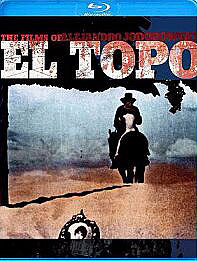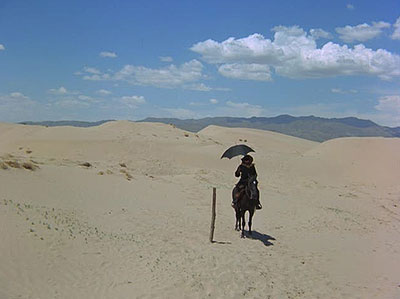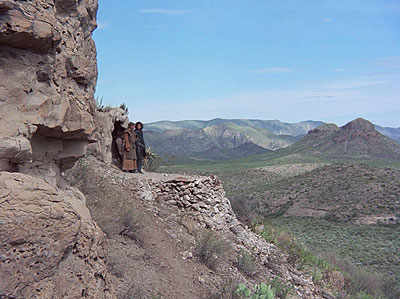Too Much Perfection Is Not A Mistake: Sound And Landscape In El Topo
Published on December 5th, 2011 in: Blu-Ray, Dancing Ourselves Into The Tomb, DVD/Blu-Ray Reviews, Issues, Movie Reviews, Movies, Soundtracks and Scores, Underground/Cult |
Preface
For those who have never seen an Alejandro Jodorowsky film, describing one seems a daunting task. Furthermore, once you have seen a Jodorowsky film, such descriptions prove to be a poor substitute for the experience itself.
At present, Jodorowsky is 82 years old. With a life full of many artistic accomplishments, a description of them all is beyond the scope of an analysis of his films, but some introduction is needed in the hopes of illuminating how his background has informed his art.
He was born in Chile in 1929 to Jewish Ukranian immigrant parents. Later, he lived in both Mexico and Paris, starting his own mime theater troupe and becoming immersed in the Panic Movement, a collective of performance artists inspired and influenced by Antonin Artaud and Luis Buñuel, and who included in their ranks Roland Topor, co-author of the screenplay for La Planète Sauvage.
Much of the symbolism and iconography of Jodorowsky’s films is influenced by religion and mysticism, so much so that a book (or at least a doctoral dissertation) could likely be written about each film examining nothing but those themes. For the uninitiated, this would be off-putting and overwhelming and may not stimulate the desire to see a Jodorowsky film. By focusing on some of the more immediate and thought-provoking aspects, however, I hope to encourage more film fans—as well as fans of art, spirituality, and counterculture—to delve into his complex, frequently beautiful, yet sometimes horrifying world.
El Topo, which translates as “The Mole,” explores the journey of the titular character and is as influenced by Spaghetti westerns as it is Eastern mysticism. Music plays a role in many religious experiences, and that of El Topo is no exception. El Topo plays a flute throughout the film, and the opening flute music (called “Burial of the First Toy” on the Abcko soundtrack) is his musical motif. The melody is instantly memorable and in fact, continues, with some variations, throughout the entire film. (Jodorowsky, along with Mexican composer Nacho Mendez, wrote the score to the film, and also plays the character of El Topo.)
The music is a perfect complement to the sound design, much of which is non-diegetic or overdubbed, but presented as within the world of the film. This heightens the emotional effect of various scenes or the experiences of specific characters.

When El Topo and his son ride into the town whose human and animal residents have been slaughtered by the Colonel and his bandits, we hear the sounds of vultures and the buzzing of crickets, yet we see no vultures or crickets. This, quite literally, amplifies the aura of death and decay.
In addition, there are scenes where human sounds have been replaced with those of animals. When El Topo kills the second gun Master’s mother, her screams are not human, but like a chirping bird in distress (Jodorowsky has explained that he wanted a bird sound, but manipulated a rat sound instead). This could imply that the mother is more connected with the animal world or that she is somehow more than just human (her son had previously referred to her “divine presence”).
In the second half of the film, after El Topo has found a group of deformed outcasts living in a cave, there is a scene in which several rich women, wearing negligees, are sitting in a dressing room, ordering an African man to fix their hair, apply lotion to their skin, and other tasks. They pounce on him, knock him to the ground, and molest him. Instead of human noises, we hear what sounds like lions growling and eating their prey, and the implication—that the women are predators—is made clear.
Many of the sounds in the film seem to have been exaggerated for effect. El Topo tracks down some of the bandits, cornering them near a small pond in an outcropping of rock inhabited by hundreds of goats that are noisily and repeatedly bleating. As he shoots the men, demanding who is responsible for the slaughter, their bleating gets louder and louder, thus increasing the tension of the scene. Here there is no music, only the animal noises, which serve as a visceral reminder of the lives lost.
In another scene, El Topo and his son enter a chapel in which several men have been lynched and the creaking noise of ropes against wood is so loud as to be almost deafening, giving the impression that the scene is not only overwhelming to the viewer but to El Topo himself. Later in the film, when El Topo is stalking around the Colonel in a circle, waiting to kill him, we can hear the sound of the Colonel’s boot heels on the ground. He is wearing thigh-high, Cuban-heeled boots along with full military-style attire, a face full of makeup, and a toupee. The sound, almost like a woman’s high heels on concrete, emphasizes his over-the-top vanity as well as his weakness.
The significance of sound and music in a Jodorowsky film cannot be diminished. It is clear that he uses both for specific purposes. In an illuminating 2008 interview with Damien Love for Bright Lights Film Journal, he explained, ” For me the music is not there to accompany, it’s not a pointer. It’s a character.” One can also consider that in a Jodorowsky film, the setting is a character.
El Topo was filmed in Mexico and at the risk of using a clichéd term, the locations are breathtaking, even more so on the restored Blu-Ray that was released in April of this year. Due to an ongoing battle with Beatles manager Allen Klein, who financed Jodorowsky’s The Holy Mountain in 1973 and who owned the rights to both films, El Topo was unavailable except in bootleg form for many years, until a restored version was released on DVD in 2007. Comparing images of the previous bootleg PAL and VHS copies and the current DVD and Blu-Ray versions is astonishing, even revelatory.
We think of a desert as a barren place, but in El Topo, the desert is alive. When El Topo and his son (and later, Mara) are traversing the desert, the vibrant blue sky saturates the top half of the screen and the sand—not just a blank canvas of beige, but a shifting, moving entity—provides high contrast on the bottom half. Even the hills and mountains are rich with variegated shades of brown and black, punctuated by plants and trees of vivid green.
After freeing Mara from the Colonel, El Topo brings her to a spectacular rock formation encircling a pond. The rocks look like long, rectangular crystals while the water itself is full of green algae and plants. The place where the second Master dwells is a canyon of sedimentary rocks, surrounded by a rushing stream cutting through the sand. Even the cave to which the outcasts have been banished is beautiful, encrusted with stalactites.
The landscapes in the movie are portrayed as immense, immeasurable even. Not only does El Topo need to conquer his own ego, he must also conquer the landscape itself. Yet even in the end, he remains as he is depicted in the beginning, a mere speck in the vastness of the universe.

The Anchor Bay Blu-Ray of El Topo was released on April 23, 2011 and is available on their website.
The Blu-Ray features include:
—New HD transfer from original negative under the supervision of Alejandro Jodorowsky
—Original Academy Aspect Ratio: 1.33:1
—DTS-HD Master Audio 5.1 & PCM Stereo
—Feature Commentary by Alejandro Jodorowsky
—English feature dub track
—On-Camera interview with Alejandro Jodorowsky
—Original theatrical trailer
—Photo Gallery
—Original script excerpts
—English, French, Spanish, Brazilian Portuguese subtitles
One Response to “Too Much Perfection Is Not A Mistake: Sound And Landscape In El Topo”
December 31st, 2011 at 2:05 pm
[…] seen one of his movies. The recent Blu-Ray editions of El Topo and The Holy Mountain (reviewed here and here literally blew my mind. If there were more artists like Jodorowsky around, the world would […]
Time limit is exhausted. Please reload the CAPTCHA.